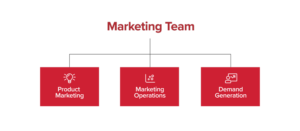This is post #4 in a 10-part series on the New B2B Marketing Paradigm.
In the last post, we discussed how to strategically create and distribute high-quality content in order to earn (and keep) attention from your target audience.
In this post, we’ll talk about how to structure your team and processes in order to enable this kind of high-quality content generation. After all, organizations are structured in many different ways. But your organization should be aligned to focus on the problems you need to solve.
Organizations are structured in many different ways. But your organization should be aligned to focus on the problems you need to solve.
Of course, there’s no one way to design an organization. Many factors come into play—including the available talent, your market’s needs, and your budget. But, we’ve found that the most successful marketing departments are composed of three key functional areas: product marketing, marketing operations, and demand generation.
 Product Marketing: The Content Creators
Product Marketing: The Content Creators
Your product marketing team is responsible for creating the brand story for your go-to-market strategy. It owns content creation from the top of the funnel all the way through the sales process. This team should align closely with product management, collaborating with the product owners to define the market, message and story for each product line.
By gaining a nuanced understanding of the market’s needs and business problems, as well as how the company’s products solve them, product marketing can create relevant, meaningful content that your audience will find valuable.
Here’s the hard part, though: staying far enough ahead of the demand generation team to create enough content to go around. We recommend a 90-day runway. Here are some suggestions for how to do that:
- By the time each quarter begins, make sure all the content you plan to publish during it is complete and ready to go. Then, spend the next 90 days planning and developing the upcoming quarter’s content.
- Meet regularly (every other week, perhaps) to discuss the latest needs of 1) product management, and 2) demand generation. Use these needs to drive your plan for future content.
- When it comes to the details, allow the people doing the work (not leadership) to build the process. The more control you can give them over how the organization’s content needs are executed, the more they will buy into the vision.
This 90-day runway ensures a steady flow of relevant and timely content into the demand generation stream, without all the fire drills and last-minute changes.
Marketing Operations: The Missing Link
Marketing operations is often misunderstood. In many organizations, it doesn’t even exist, or if it does, the responsibility is shared. And yet its role is critical to the success of marketing. That’s because, in order to effectively build great content and distribute it across multiple channels, you also need the data and technology that empowers you to execute and measure these efforts.
A fatal flaw across companies with weak marketing operations is that they’re relying on data from sales as their single source of truth. In reality, that data is intended for sales—not marketing.
What’s the difference? Platforms like Salesforce are designed to allow salespeople to easily enter customer data in real time. They’re not designed for marketing to be able to extrapolate meaningful findings about their demand gen efforts. Thus, marketing folks will find that they simply aren’t able to run the queries they need to using sales tech. Instead, they must have a system that was specifically designed for marketing—whether it’s Marketo, HubSpot, or something else (even Salesforce Marketing Cloud). Then, not only will marketing be able to access the nuanced data they need to understand what’s working, what’s not, and how to tweak their strategy moving forward—they’ll actually be able to better prove their own value as well.
Platforms like Salesforce are designed to allow salespeople to easily enter customer data in real time. They’re not designed for marketing to be able to extrapolate meaningful findings about their demand gen efforts.
Marketing operations should be a distinct team, focused solely on prioritizing and supporting the needs of marketing. This way, it can effectively provide the data and technology that will drive the efforts of your product marketing and demand generation teams.
Demand Generation: Where the Rubber Hits the Road
The demand generation team uses the technology from marketing operations and the content from product marketing to:
- Drive new traffic to the company’s website
- Nurture that traffic to determine when prospects are “in market”
- Deliver qualified leads to the sales team
We’ll discuss this process in more detail in our next post.
At the end of the day, organizational design is not just about who lives in what box. It’s also about the processes you put in place to ensure collaboration and execution across teams. We hope the information above has provided some guidance. But if you find yourself needing more, don’t hesitate to reach out.
